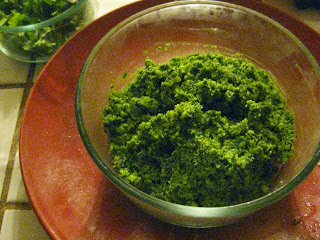Not long ago, I saw a reference to a "Spanish tortilla," something very different from the tortillas we associate with Mexican dishes. While in Barcelona Spain recently, I had an opportunity to try some "authentic" tapas, including the "Spanish tortillas" I had heard about.
As with almost all the tapas we tried, these were delicious, so I came home ready to do more research into making my own. Following is what I found to be a real favorite for our family, something that would make a great brunch dish or even a light supper. Because of the typical Spanish custom of serving this at room temperature, it could even be a good potluck dish--though I would not want to leave it at room temperature for an hour or so.
This version is larger than the tortillas served as tapas. Those were more individually sized, and some had a layer of sliced tomatoes under this potato egg dish. This one would be best served as narrow wedges, something like you might serve a quiche. There is just a small challenge in getting the finished dish out of the pan in one piece, but using enough oil in a well-seasoned cast iron skillet made the job pretty easy.
This is good just as is, but either a little salsa or pesto (like this one: http://frugalfastfun.blogspot.com/2015/05/cilantro-and-spinach-pesto.html) can also be a good accompaniment.
Spanish Tortilla
11 oz potatoes, thinly sliced (2 medium), app 2 c when
sliced
4 oz chopped onion (1 c)
2 cloves garlic, chopped
½ t salt (will probably want more)
black pepper to taste
¾ c olive oil
3 eggs
Method:
1. Add all the oil to a skillet and begin to warm over medium heat. Add potatoes, onions, and garlic and season with salt and pepper. The oil should almost cover the potatoes. Cook slowly until the potatoes are just tender, probably about 12 to 15 minutes, stirring gently a few times. Remove from heat and put in a colander to drain until just warm. (Save oil for re-use.)
2. Meanwhile, beat the eggs in a large bowl until the mixture is uniform in color. Stir the just warm potatoes into the eggs. Heat the oven to 375 degrees in preparation for the final step.
3. Add just enough of the reserved oil to be sure skillet is just covered with a sheen of oil. (You don't want a lot, but you also want to be able to turn the tortilla out of the pan in one piece!) Heat the pan to medium high.
4. Pour the potato mixture into the pan and spread out evenly. Cook for about 5 minutes, using a spatula around the edges to occasionally loosen the eggs from the pan.


5. When the edges begin to look set and cooked but the center is still liquid, place the skillet in the pre-heated oven and allow to cook another 8 to 10 minutes, until the center is fully set.
6. Remove from oven and turn onto a plate, using a spatula as needed to gently loosen the tortilla from the pan in one piece. May be served hot or, apparently typical in Spain, at room temperature.

Note that the reserved oil amounted to a full half cup, so the total used in this recipe was "only" a quarter cup. The oil that remained was nicely flavored with the onion and garlic, so it will be useful for sauteeing vegetables, etc.
Update on June 22, 2015:
I can't resist adding this link with more info on Spanish tortillas:
http://www.nytimes.com/2015/06/21/magazine/the-king-of-tapas.html?rref=collection%2Fsectioncollection%2Fmagazine












